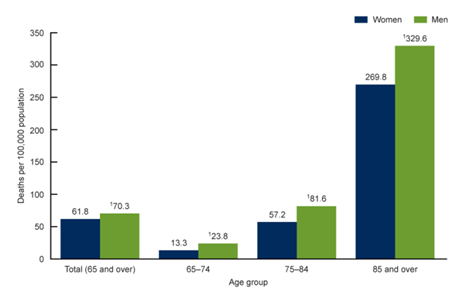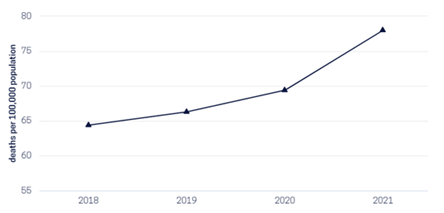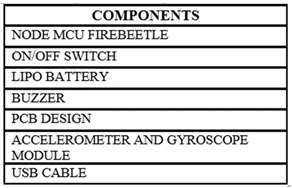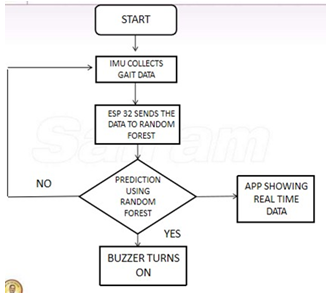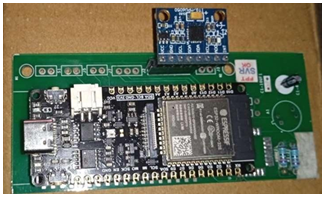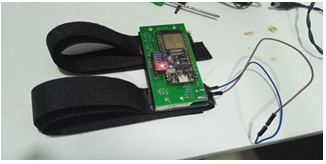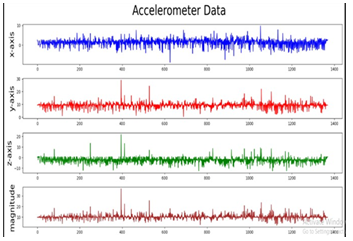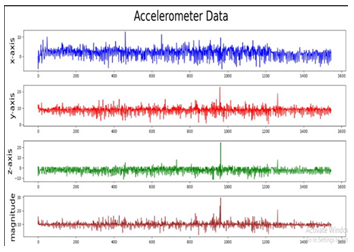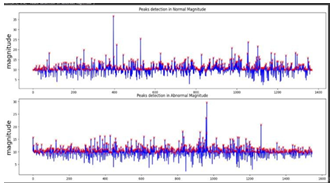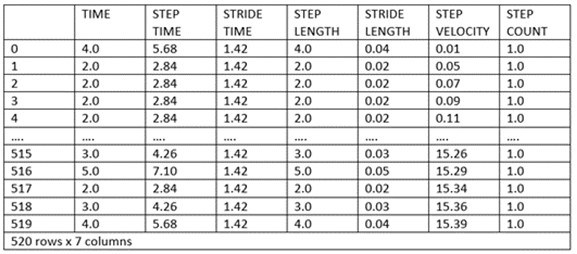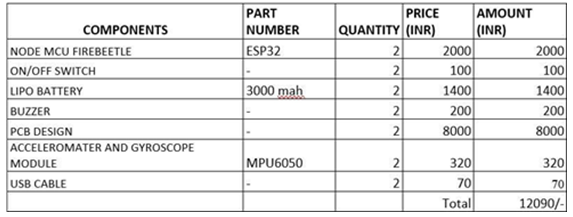An Automated Wearable Fall Detection System for Elderly People
Written by N. Anitha, R.B. Vishnu Vardhan, R. Pradeep, and A. R. Nazeem
According to the World Health Organization (WHO), the number of individuals aged 60 or older is projected to reach around 2 billion by 2050, a significant increase from 900 million in 2015, constituting approximately 22% of the global population. Aging is commonly associated with a decline in physical, sensory, and cognitive abilities, which elevates the risk of experiencing falls. It has been reported that around 28-35% of elderly individuals aged 65 and above require hospitalization due to falls. The risk of falling escalates with age-- for elderly adults aged 70 or older, the likelihood of falling stands at 32-42%. Falls in advanced age come with the added burden of sustaining moderate to severe injuries, including fractures of the wrist, arm, ankle, and hip. To address these issues, this article presents a machine learning method that exploits Gait Analysis. The proposed machine learning method uses walking patterns to test falls and non-falls.
Introduction
A fall is characterized as an incident that leads to an individual unintentionally ending up on the ground, the floor, or a lower level. Fall-related injuries can be fatal, although the majority are non-fatal. With the global population aging, the well-being of older adults has become an increasingly worrisome matter. Among the various challenges associated with aging, falls have emerged as a prominent public health concern, impacting a significant number of elderly individuals worldwide.
According to the World Health Organization, falls are the primary cause of injury-related fatalities in people above a certain age. Falls rank as the second most significant contributor to unintentional injury fatalities on a global scale, with approximately 684,000 people losing their lives due to falls worldwide. Over 80% of these incidents occur in low- and middle-income countries. Fatal falls disproportionately affect individuals aged 60 and above. Around 37.3 million falls necessitating medical attention are reported each year. Preventive measures should focus on educating and training individuals, promoting safer surroundings, prioritizing research on falls, and implementing effective policies to mitigate risks [3].
Falls among elderly individuals are a significant health concern with potentially severe consequences. As people age, their physical strength, balance, and coordination may decline, making them more susceptible to falls. Falls can lead to a range of injuries and negative side effects that impact the overall well-being and quality of life of older adults. Understanding the risks and consequences associated with falls is crucial for healthcare professionals, caregivers, and society at large to develop effective preventive measures and appropriate interventions. Fall detection is a field of research and technology focused on identifying and responding to instances when individuals, especially the elderly or people with mobility issues, experience a fall [1]. Rapid detection and timely intervention can greatly reduce the negative consequences of falls, making fall detection systems an essential component of healthcare and assistive technologies [2].
In 2020, the total unintentional fall death rate among individuals aged 65 and above was 70.3 per 100,000 population for males and 61.8 for females. In every age group, males experienced higher rates of unintentional fall deaths than females. The lowest rates were observed in the 65-74 age group, with 23.8 for men and 13.3 for women. Conversely, the highest rates occurred in the 85 and over age group, with 329.6 for men and 269.8 for women. Among adults aged 65 and above, the rates of unintentional fall deaths increased as age advanced for both males and females.
Figure 1: Fall deaths in different age groups.
The proportion of fall deaths in 2018 was 65 per 100,000 population, and it gradually rose in 2019, reaching approximately 70 per 100,000 population around 2020. The rate of increase for fall deaths appears to double and approach nearly 80 per 100,000 population by 2021. A significant number of fall-related deaths can potentially be prevented if detected early on [4].
Figure 2: Fall deaths percentage in recent years.
Literature Survey
Sensor Based Approaches:
Sensor-based approaches in fall detection utilize various types of sensors, such as accelerometers, gyroscopes, pressure sensors, and infrared sensors, to continuously monitor an individual's movements [5]. By analyzing the data from these sensors, algorithms can detect anomalous patterns indicative of a fall event. These non-intrusive and real-time systems offer promising solutions to promptly identify and respond to falls, enhancing the safety and well-being of elderly individuals. However, challenges such as false alarms and device placement need to be addressed to ensure the reliability and effectiveness of these fall detection technologies.
Machine Learning and Artificial Intelligence:
Machine learning (ML) and artificial intelligence (AI) play pivotal roles in fall detection systems [6]. By analyzing sensor data from accelerometers, gyroscopes, and other sources, machine learning algorithms can learn patterns associated with falls and differentiate them from normal activities. AI-driven models continuously adapt and improve their accuracy over time, making them robust and efficient in real-time fall detection. These technologies enhance the reliability and responsiveness of fall detection systems, leading to timely assistance and improved safety for elderly individuals.
Vision-Based Approaches in Fall Detection:
Cameras and computer vision techniques can be leveraged to monitor and analyze the movements of individuals [7]. These systems can detect falls by identifying distinct body postures and motion patterns indicative of a fall event. By tracking key points on the human body, such as joints and limbs, vision-based algorithms can accurately distinguish falls from regular activities.
While offering potential advantages in unobtrusiveness and coverage of large areas, vision-based fall detection systems may face challenges in low-light conditions or occluded views. Nonetheless, ongoing advancements in computer vision technologies continue to improve the accuracy and practicality of these solutions in enhancing the safety and well-being of elderly individuals [8].
Real-Time Alert-System-Based Approaches in Fall Detection:
Real-time alert system approaches utilize sensors, cameras, or wearable devices to continuously monitor an individual's movements [9]. These systems are designed to immediately detect falls and promptly issue alerts to caregivers, medical personnel, or emergency services. By leveraging advanced algorithms and data processing, real-time alert systems can quickly distinguish falls from normal activities, and by sending automatic alerts, these systems can minimize response time and help to provide timely assistance to affected individuals [10]. Proactive solutions aim to enhance the safety and independence of elderly individuals by ensuring rapid support in the event of a fall, reducing the risk of severe injuries and improving overall well-being. The scientific research conducted in fall detection aims to address the challenges associated with accuracy, false alarms, user acceptance, and real-world deployment. By advancing these technologies, researchers strive to improve the quality of life for individuals at risk of falls.
Proposed Solution
The proposed fall detection device for elderly individuals offers a cost-effective solution with exceptional accuracy. It continuously measures six gait parameters in real-time: step time, stride time, step length, stride length, step velocity, and step count. The device is designed to be user-friendly and to deliver faster, more accurate outcomes compared to traditional laboratory tests. By utilizing an accelerometer and gyroscope, gait analysis is employed to predict potential falls and issue timely alerts.
The core of the device is the MPU 6050 sensor, which continuously collects real-time data. This data is then sent to a random forest algorithm that separates it into the six gait parameters and checks for abnormalities. If any irregularities are detected, the device triggers a buzzer to alert the elderly person. Additionally, a companion app has been created using React Native, enabling real-time data display and offering various features that can be beneficial for hospital use by medical professionals.
Targets
This project aligns with the Sustainable Development Goals (SDGs) of the United Nations, specifically:
Goal 3 - Ensure Good Health and Well-being
Goal 12 - Promote Responsible Production and Consumption.
Our objective is to contribute to the SDG revolution and support elderly individuals by implementing these systems, ultimately aiming to achieve these goals by 2030.
Methodology
Module 1
The SIM900A GSM GPRS Module is an ultra-compact and reliable wireless module. Using this module, we can send a message to the mobile phone app when the system detects the risk of a fall. The major sensors used to analyze body movement are the accelerometer and gyroscope. The Arduino Uno, an open-source microcontroller board, is used to gather data from the sensors and the GSM module. The data from the sensors are then sent to a smartphone using the GSM module.
Module 2
The NEO 6M GPS module is a well-performing complete GPS receiver that provides a strong satellite search capability. The GPS module is interfaced between Arduino and the GSM module. The GPS module tracks location, and when a fall is detected, it sends the current location of the user to the caretaker through the GSM module via the Microcontroller. This indicates the risk of a fall injury to the caretaker.
Module 3
The main aim of the system is fall prevention. To achieve this, gait parameters such as step time, stride time, step length, stride length, step velocity, and step count, along with maximum pressure values on the heel and toe, are gathered in real-time using an IMU- Inertial Measurement Unit (Accelerometer, Gyroscope, Magnetometer). The real-time gathered data is then sent to the inbuilt cloud of ESP32. Next, the real-time data is analyzed using a pattern recognition algorithm. The random forest algorithm classifies whether the individual may fall or not. This system aims to detect potential fall risks in advance and take appropriate preventive measures.
Module 4
The next step involves developing a machine learning code to predict pre-fall incidents. All the real-time data collected is stored in the application. The machine learning code will analyze the gathered data, and based on the pattern recognition algorithm (such as random forest), it will predict whether a pre-fall situation is likely to occur. The application will present this information in real-time, allowing caregivers or relevant personnel to take prompt preventive measures and provide necessary assistance to the individual.
Final Integration
The dataset gathered from the accelerometer and gyroscope is utilized to derive six key parameters: step time, stride time, step length, stride length, step velocity, and step count. By combining the data from these sensors, we can determine these parameters accurately. The average walking speed of a typical individual is recorded as 1.42 meters per second.
Each of the six parameters are separately determined by respective formulas such as
step_times_ab=np.diff(peaks).
step_length_ab = walking_speed * step_times_ab
step_velocity_ab= step_length_ab / step_times_ab
step_count_ab = np.diff(peaks)
stride_time_ab = np.diff(peaks) / 100
Components
The cost-effective solution of the proposed fall detection device is shown in Fig. 3. Analysis of the cost-effectiveness of this solution is under the subheading “Cost Solution.”
Figure 3: Component details.
Working of the System
The system's comprehensive functioning is depicted in the flow diagram presented below. The diagram illustrates the step-by-step operations of the system. Real-time data is collected employing the MPU 6050, a motion detector, which is sent to the ESP32 microcomputer featuring a built-in cloud for data retention. Then, the preliminary fall forecast is generated via the utilization of the random forest technique. Upon obtaining the forecast, the buzzer is activated to notify the senior individual. Simultaneously, the live data is exhibited in a mobile application constructed using React Native.
Figure 4: Flowchart of the system.
The hardware and software of the system are explained in following sections. The final prototype is shown in Figure 6.
System Hardware:
Firstly, all the Esp 32 fire beetle and all the hardware are PCB designed using fr4 material.
Figure 5: PCB design.
The microcontroller component utilizes an ESP32 microcontroller as the central processing unit, while the power source is a 3V 3000h Lithium Battery. The design of the system allows it to be worn on both legs by elderly individuals. Additionally, the system is equipped with a buzzer to provide pre-fall alerts, and it includes a battery and an on/off switch for convenient system shutdown when not in use.
Figure 6: Prototype of the system.
System Software
The real-time data is collected using the accelerometer and gyroscope. Then, the data is sent to the random forest algorithm, with ESP32 as the microcontroller. Using the random forest, the extracted features for normal and abnormal patterns in the accelerometer are displayed. This analysis allows the system to distinguish between normal movements and potentially risky movements, aiding in the detection of abnormal gait patterns that might indicate a risk of falling [11].
Figure 7: Normal data of accelerometer.
Figure 8: Abnormal data of accelerometer.
In the same manner, the extracted features for normal and abnormal movements are obtained from the gyroscope data. By using the graphs of normal and abnormal data from both the accelerometer and gyroscope, the maximum peak detection features are gathered. This allows us to determine the number of steps taken by a person. Using this step count information, the system can further assess and analyze the person's movement patterns and identify any potential fall risks.
Figure 9: Maximum peak detection.
By using all the formulas stated in Methodology, the six parameters are determined (step time, stride time, step length, stride length, step velocity, and step count, along with the maximum pressure values on the heel and toe). These parameters are essential in analyzing gait patterns and assessing potential fall risks in individuals [12].
Results:
Fig. 10 represents the six gait parameters of age group 65+.
Figure 10: Six gait features.
The above result represents average gait features of 10 elderly people extracted from a group of individuals 65 & above.
Cost Analysis
Figure 11: Cost analysis.
The above reflects the cost of one elder person wearing the device on both knees.
Lessons Learned
The reviewed papers focused on developing systems that detected post-fall incidents, but their accuracy was notably low. Moreover, these systems often relied on multiple sensors, making them less user-friendly. In contrast, our project addresses these limitations by successfully predicting pre-fall events and achieves higher accuracy while utilizing fewer sensors, enhancing user-friendliness.
Conclusion
This article proposes a simple and user-friendly method to extract gait features-- a method that is not used in existing prevention systems, and is of reasonable cost to the public. The simplicity is achieved by a single motion sensor, MPU6050, to detect the pre-fall, combined with the use of random forest. ESP32 is also used to increase the process speed of the operation.
Ultimately, the model must undergo testing on publicly gathered datasets encompassing diverse activities and various types of falls. This model holds considerable potential in addressing the issue of falls by promptly alerting relevant response teams to take essential measures. It is expected to accelerate the assistance process, minimize the likelihood of prolonged harm, and potentially save lives. To achieve this, gait parameters such as balance, step time, stride time, stride length, step velocity, step count, and pressure on heel/toe are gathered using Inertial Measurement Units (IMUs) comprised of accelerometers, gyroscopes, and magnetometers. The real-time gathered data is then analyzed using the pattern recognition algorithm, Random Forest. Health parameters such as body temperature, blood pressure, and pulse rate are also checked. Based on this information, an intimation is given through a mild alarm to the affected elderly individual. This article addresses the novelty of this six-parameter approach and the mild alarm, and how these novel approaches contribute to fall prevention and improved safety for elderly individuals.
Future Scope
The system can be enhanced through the inclusion of additional gait parameters such as cadence, swing time, support time, double support time, number of steps per day, gait speed, and heel acceleration slope. These additions will provide even more accurate and precise warnings to the elderly person. Furthermore, the current buzzer can be substituted with a trigger or voice note, allowing customization based on the user.
Acknowledgment
The real time data is gathered from elderly participants in-home and Sairam institution staff.
References
- Ji, X., Dong, Z., Han, Y., Lai, C. S., Zhou, G., & Qi, D. (2023). EMSN: An Energy-Efficient Memristive Sequencer Network for Human Emotion Classification in Mental Health Monitoring. IEEE Transactions on Consumer Electronics. Early Access
- Fong, B., Fong, A. C. M., & Li, C. K. (2020). Telemedicine technologies: information technologies in medicine and digital health. Wiley.
- Wang, J., Zhang, Z., Li, B., Lee, S., & Sherratt, R. S. (2014). An enhanced fall detection system for elderly person monitoring using consumer home networks. IEEE Transactions on Consumer Electronics, 60(1), 23-29.
- Lai, C. F., Huang, Y. M., Chao, H. C., & Park, J. H. (2010). Adaptive body posture analysis using collaborative multi-sensors for elderly falling detection. IEEE Intelligent Systems, 24(6), 20-30.
- Tao, J., Dong, M., Li, L., Wang, C., Li, J., Liu, Y., Bao,R. and Pan, C.,2020. Real-time pressure mapping smart insole system based on a controllable vertical pore dielectric layer. Microsystems & nanoengineering, 6(1), pp.1-10.
- Bucinskas, V., et al., 2021. Wearable feet pressure sensor for human gait and falling diagnosis. Sensors,21(15),p.5240.
- Cagnoni, S., Matrella, G., Mordonini, M., Sassi, F., & Ascari, L. (2009, November). Sensor fusion-oriented fall detection for assistive technologies applications. In 2009 Ninth International Conference on Intelligent Systems Design and Applications (pp. 673-678). IEEE.
- 8. Ding, J., & Wang, Y. (2020). A WiFi-based smart home fall detection system using recurrent neural network. IEEE Transactions on Consumer Electronics, 66(4), 308-317.
- Chen, Tingting, Zhenglong Ding, and Biao Li. "Elderly Fall Detection Based on Improved YOLOv5s Network." IEEE Access 10. 91273-91282. (2022):
- Zhang, J., Wang, M., Lin, L., Yang, X., Gao, J., & Rui, Y. (2017). Saliency detection on light field: A multi-cue approach. ACM Transactions on Multimedia Computing, Communications, and Applications, 13(3), 1-22.
- Shi, Bohan, et al. "Detection of Freezing of Gait using Convolutional Neural Networks and Data from Lower Limb Motion Sensors." IEEE Transactions on Biomedical Engineering,69,2256-2267, (2022)
- Attal, Ferhat, Abderrahmane Boubezoul, Allou Samé, Latifa Oukhellou, and Stéphane Espié. "Powered two-wheelers critical events detection and recognition using data-driven approaches." IEEE Transactions on Intelligent Transportation Systems 19, no. 12 (2018): 4011-4022.
Keywords: detection, Random forest, Accelerometer, Gyroscope, Gait analysis
This article was edited by Bernard Fong.
To view all articles in this issue, please go to August 2023 eNewsletter. For a downloadable copy, please visit the IEEE Smart Cities Resource Center.
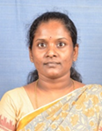



To have the eNewsletter delivered monthly to your inbox, join the IEEE Smart Cities Community.
Past Issues
To view archived articles, and issues, which deliver rich insight into the forces shaping the future of the smart cities. Older eNewsletter can be found here. To download full issues, visit the publications section of the IEEE Smart Cities Resource Center.


